Summer woes
How to succeed in the toughest walleye weather
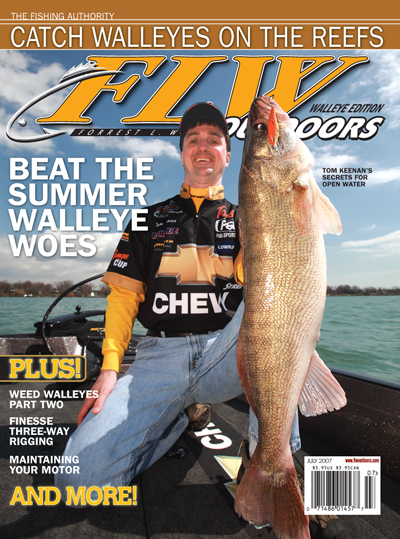
Chevy pro Tom Keenan of Hatley, Wis., the 2006 Land O’Lakes Angler of the Year on the Wal-Mart FLW Walleye Tour, heard all kinds of stories when he was growing up as to why anglers in the old days thought walleye fishing got tough in summer.
Some old-timers believed species with sharp teeth like walleyes, muskies and northern pike developed sore mouths, lost their teeth and didn’t bite until they grew new ones.
We know a lot more about walleye behavior today. Several factors conspire to make walleyes harder to find and catch during the hot months.
For one, the water is full of young-of-the-year fish. Activity periods are brief because hungry walleyes can quickly eat their fill.
In bodies of water where suspending species like shad, white bass, ciscoes and whitefish are the main forage, huge schools of walleyes abandon main structures where they were found in spring and head to open water. Like moving targets, moving fish are hard to hit.
Even in lakes where bottom-dwelling perch are the walleyes’ primary diet, huge mayfly hatches cause walleyes to suspend at times. They seem to disappear when anglers only target the lower end of the water column.
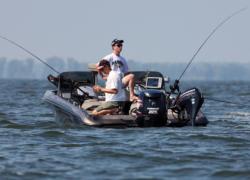 Thermocline also plays a role. Walleyes are forced to shun deep structures with too little oxygen to support life.
Thermocline also plays a role. Walleyes are forced to shun deep structures with too little oxygen to support life.
But, even when the heat is on, the right combination of location and presentation still puts fish in the boat. Certain types of structure and cover always seem to hold fish, and catching open-water walleyes isn’t as tough as you might think.
Open-water workout
Trolling is often Keenan’s method of choice when suspended walleyes are gorging on a midyear buffet. At times like those, the best bet may be to show a lure to as many fish as possible in order to pluck off the active ones or provoke reaction strikes.
But, don’t expect a relaxing boat ride to work on a tan. Keenan works up a sweat. He’s in motion all the time, adjusting tactics until he finds something that works, and even then, he’s never satisfied. He keeps right on fine-tuning.
Scouting is always critical on new water. Visit Web sites, make the usual rounds of bait shops and glean what you can from the locals at boat ramps. The goal is to narrow the search. Once on the water, look for signs of baitfish on your sonar screen or an insect hatch on the surface. Minnows will boil on the surface, and white bass will attack from below. Also look for diving seagulls.
Once potential hot spots are known, never assume how deep the fish will be based solely on the type of forage present. Although walleyes in perch-dominated systems may often be near the bottom, Keenan has seen times when insect hatches have brought walleyes to the surface to feed like trout over deep water. In contrast, a cold front can force fish deep even in shad-dominated lakes. As a result, sifting the water column is critical every time you troll.
“All fish are not high, and all fish are not low,” Keenan said. “If you’ve never been there before, go to the bottom with bottom bouncers right off the side. Put a couple of other lines down midway with snap weights or keel sinkers and a couple more really high. The advantage there is that high fish are usually active fish.”
In perch-dominated systems, Keenan tries to avoid the hassle of small fish taking the bait by staying 3 to 4 feet above the bottom. Active walleyes can be lured to come up to the spinners.
Keenan relies on the Lindy X-Change system for versatility. It lets him change the size of the weight on his bottom bouncers fast to stay down as he tries different speeds to see what pace triggers the strike. The X-Change system also lets the pro change blade styles and colors quickly, which is something he does all the time.
“If we go to a restaurant, you may want a steak, and I may want a hamburger. I don’t think every walleye wants a silver hatchet blade. Another might want a purple Colorado. If I have six spinners out, four will have different colors. I’m changing my blade color constantly.”
Forget the traditional 50/50 system when deciding where to attach snap weights to the lines. Save time and get better hooksets by letting out just 30 feet before adding a 2- or 3-ounce weight. Keenan achieves different depths by changing the weight size and varying the line from 5 to 50 feet behind the weight.
Keenan may switch to keel sinkers with a leader length of 5 feet if the water is stained.
The best speed is relative to how active the fish are. Start fast first, and slow down only if you must.
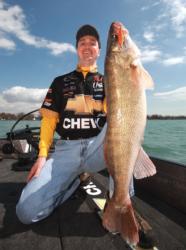 “I always push the speed limit,” Keenan said. “The faster you can get away with, the better. You cover more water. You get reaction strikes, and when you troll fast, the chances of losing fish decrease.”
“I always push the speed limit,” Keenan said. “The faster you can get away with, the better. You cover more water. You get reaction strikes, and when you troll fast, the chances of losing fish decrease.”
Fish near the bottom may be more neutral. Try putting on the brakes to get them to hit.
“Slow down; 0.8 to 1.2 mph is a great area to start,” Keenan said. “But, if you’re using snap weights or keel sinkers and fish are up and active, take the speed to 1 to 1.7 mph. A good rule is 1.4 to 1.7 mph.”
Watch the GPS to duplicate the speed when the action starts. Going faster or slower can raise or lower spinners out of the strike zone. GPS also helps keep track of the school of fish.
If he can reach 1.8 mph and still catch walleyes, Keenan switches to crankbaits. With a hard bait on the line, he can troll from 1.5 all the way up to 3 mph.
Target cover
Not all walleyes spend summers in open water. Minnows and perch seek safety in weeds and wood, and predators will be nearby – but, where?
BP pro Jason Przekurat of Stevens Point, Wis., who won earlier this year at the FLW Walleye Tour event in Red Wing, Minn., has a rule of thumb to locate walleyes throughout the year.
His theory is: “north, south, outside, in.”
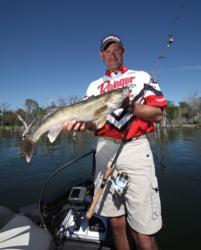 Generally speaking, early in the year the majority of walleyes in a system will be in the northern section of a lake, where water warms first. As spring progresses, walleyes disperse around the perimeter of the lake to the south. By summer, fish head to midlake reefs nearest deep water. The best structure features a variety of weeds, wood and rock to provide security for baitfish.
Generally speaking, early in the year the majority of walleyes in a system will be in the northern section of a lake, where water warms first. As spring progresses, walleyes disperse around the perimeter of the lake to the south. By summer, fish head to midlake reefs nearest deep water. The best structure features a variety of weeds, wood and rock to provide security for baitfish.
Faster presentations are still best to begin. Trolling spinner rigs without weight just over the top of massive shoreline and midlake weedbeds can be killer.
As days lengthen, vegetation thickens, reaches the surface and limits the ability to troll through the heart of the weedbeds. Spinners weighted with Lindy No-Snagg Cent’r Slip Sinkers that are worked along weed edges will produce. Before fishing a spot, travel along the weed edge to trace its shape on the GPS screen. Look for points and inside turns where walleyes pause. Places where two kinds of weeds meet are also good. The transition may signal the intersection of two different kinds of bottom content, which means a greater variety of aquatic life will be present to provide a wider menu for hungry fish.
Slow down if faster methods fail to produce.
Pitching a weedless jig and a leech into weed pockets and along weed edges is a fun, effective way to put walleyes in the livewell. Let the bait go to the bottom, and snap it a couple of times, letting it fall back to the bottom. Move on if no strike occurs.
At other times, the trick may be to dangle delicious-looking live bait right in a walleye’s face. Slip bobbers are often the best way to fill a summer limit.
We aren’t talking about the common slip-bobber rig as it has come to be known. Many anglers use any old slip bobber that might slide or not; a plastic bobber stop that can damage line; split shot that can reduce 10-pound line to the strength of 6-pound mono as soon as it’s pinched on; and a jig that features a hook too small to be effective or a plain hook so large that it hinders the bait.
“That isn’t a slip-bobber rig. That’s a recipe for disaster,” said Wisconsin guide Greg Bohn, known as Mr. Slip Bobber. He recently published “Master the Art of Slip Bobbering: The Deadliest Method for 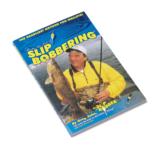 Walleye!” with Scott Richardson (for more information, visit gregbohn.com).
Walleye!” with Scott Richardson (for more information, visit gregbohn.com).
Use a slip knot made of braided line, and leave tag ends to retighten the knot as needed. Add a red glass bead to sit atop the bobber shaft to prevent the shaft from being stuck in the knot and make it easier to know if the bobber has slid all the way up the line. If not, the bait is out of place and useless.
The slip bobber must be large enough to support the bait, hook or jig; colorful enough to be seen; and shaped to offer little resistance when a strike comes. New bobbers on the market, like the Lindy Pro Series bobbers, which Bohn designed, come unweighted to support more weight on the business end, or weighted to cast farther into the wind. The weight can be removed from the weighted model. Bohn usually chooses the Pro Series weighted or unweighted in sizes 110 and 115. They support a 1/16- or 1/32-ounce Bobber Bug, a jig or a No. 4 or No. 6 hook in gold or red colors, plus live bait.
Add a swivel between the bobber and the business end. With one end larger than the other, the No-Snagg swivel will not stick in the slip bobber.
If your main line is 10-pound monofilament, make a 2-foot leader from 8-pound test, and tie on the hook, jig or Bobber Bug. That allows you to break free without losing the entire rig if you get snagged. But, you can avoid many snags and line damage by using a rubbercore sinker to balance the rig instead of split shot.
Leeches and night crawlers are the best summer live baits. Never get caught taking just one or the other or just one size of either. You never know what the fish will want. Leeches are often the easiest to use in panfish-infested weeds.
When vegetation is uniform in height, set the bobber so the bait rides 1 to 2 feet above the top. Bohn likes to anchor downwind and cast upwind. The bait will cover more area as it floats back to the boat. Just as before, when weeds get too thick to fish inside, target the points and inside turns along weed edges.
The weed bite is often during early morning and late afternoon. But, midlake rock piles can produce all day. The best ones top out in 20 feet of water or less. The ones nearest the thermocline will hold the most fish. At the depth where warmer water meets colder, less oxygenated water sometimes shows up as a line on the sonar screen if the sensitivity is turned up.
If not, look for baitfish, which will hold just above it. Use a night crawler set a foot off the bottom. Worms tend to be the bait for trophy walleyes under a float.
Midlake reefs also can be rigged. A Lindy No-Snagg sinker or bottom bouncer, a snell and a plain hook dressed with a 4-inch piece of a night crawler or a leech can produce big catches. An electric trolling motor has enough power to move it slowly along the bottom on breaklines. Again, focus on the points and inside turns where walleyes tend to congregate. Use lighter weights to achieve a 45-degree angle between the line and the water’s surface in shallow water where spooking fish may be a concern. Use heavier weights to stay more vertical in deeper water to improve hooksets.
Don’t sweat the tough summer bite. Be cool. Try several locations and tactics until you find the hot bite.